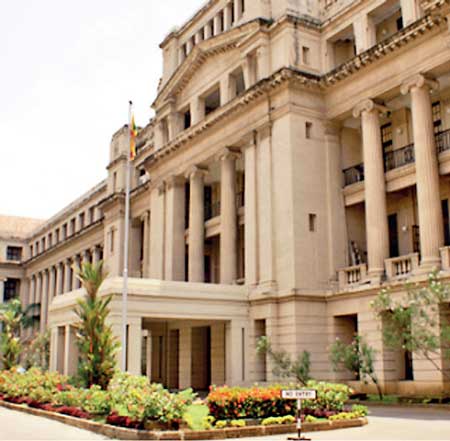Tuesday Nov 18, 2025
Tuesday Nov 18, 2025
Wednesday, 18 October 2017 00:05 - - {{hitsCtrl.values.hits}}

Moody’s Investors Service said yesterday that Sri Lanka’s (B1 negative) significant borrowing requirements and heavy reliance on external and foreign currency funding expose the sovereign to material liquidity and external financing risk, which weighs on the sovereign’s credit profile.
Despite a recent increase in foreign exchange reserves, reserve coverage of external obligations remains low. Unless reserves rise still further, reserve coverage will weaken and external vulnerability will increase from 2019 when large international debt repayments are due.
How the authorities prepare for and manage these risks will be critical to stabilising the external financing position. Reforms that continue to advance fiscal consolidation and exchange rate flexibility, along with the implementation of an effective external liability management strategy, will mitigate external risks and help support Sri Lanka’s credit profile.
Moody’s conclusions are contained in its just-released report on the Government of Sri Lanka, ‘External pressures constrain credit profile’.
Moody’s assesses Sri Lanka’s external vulnerability as “Moderate”, reflecting its view that sudden shifts in external conditions could weaken the sovereign’s credit profile.
This external vulnerability stems from the structure of the country’s government debt, with large shares of external financing and foreign currency debt combining to heighten the Government’s susceptibility to changes in financing conditions.
As of 2016, total external debt (local and foreign currency external debt of combined public and private sectors) was about $ 47 billion (about 57% of GDP), of which approximately 68% was public sector debt.
Meanwhile, the Government’s foreign currency-denominated debt was about 43% of total general government debt in 2016 and about 34% of GDP.
Moody’s notes that Sri Lanka’s foreign currency reserves fell to a low of $ 4.1 billion in April 2017 from a peak of just over $ 8.1 billion in August 2014, but by August 2017 reserves had been rebuilt to $ 6.7 billion.
Despite this improvement, reserves adequacy remains relatively weak and Sri Lanka has several large external debt repayments due between 2019 and 2022. The bunching of these future external liabilities, which will average $ 3.6 billion per year, raises rollover and external vulnerability risks.
Meanwhile, the debt-financing of Sri Lanka’s persistent current account deficits adds to future external financing needs.
Sri Lanka’s current account deficits, at 2.4% of GDP in 2016, are driven by large structural trade deficits and add to external financing requirements. Annual net foreign direct investment (FDI), which was 1.2% of GDP in 2016, does not fully fund the deficit. Hence, the current account deficit will continue to be partly financed through debt inflows, leading to further accumulation of debt liabilities.
At the same time, reforms could help to reduce Sri Lanka’s external vulnerability, but their impact is not fully clear yet.
Moving forward, sustained fiscal consolidation and a more flexible exchange rate will have a credit positive impact by reducing external borrowing requirements and preserving foreign exchange reserves. However, the design and implementation of an effective and transparent external liability management strategy remains incomplete. How these multipronged reform areas combine and shape external vulnerability will help determine Sri Lanka’s credit profile.